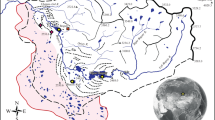Abstract
Lake Baikal is the world’s deepest (1637 m) and oldest (Late Oligocene-Early Miocene) lake, with a length of 636 km and a width ranging from 30 to 87 km (Karabanov and Fialkov 1987; Mats 1992). It is located in south-eastern Siberia within the Baikal Rift System at the southern edge of the Siberian Platform (Hutchinson et al. 1992; Mats 1992). The borders of Lake Baikal are characterized by high topographic relief that reaches 2700 m in the intensely glaciated mountains on the eastern side of the North basin (Atlas of the Irkutsk Region, Lake Baikal 1:500000 map). Several small rivers drain the large glacial valleys into this north-eastern side of the lake (Fig. 6.1). The large Selenga River flows into the south-eastern side of the lake from north central Mongolia. The muddy delta of this dominant sediment source progrades far into the lake and overlies the accommodation zone ridge between the Central and South basins (Fig. 6.1). Only local streams of less than 20 km length feed numerous coarse-grained fan deltas and alluvial fans along the western margin of the lake (Atlas of the Irkutsk Region, Lake Baikal 1:500000 map; Mats 1992).
Access this chapter
Tax calculation will be finalised at checkout
Purchases are for personal use only
Preview
Unable to display preview. Download preview PDF.
Similar content being viewed by others
References
Colman, S.M. and Lake Baikal Paleoclimate Project Members. 1992a. Initial Results of the Joint American-Russian Project on the Paleoclimate Record of Lake Baikal, Southeastern Siberia. EOS Transactions, American Geophysical Union, 73, 457, 460-462.
Colman, S.M., Karabanov, E.B., Williams, D.F., Hearn, Jr, P.P., King, J.W., Oren, W.H., Bradbury, J.P., Shanks, III, W.C., Jones, G.A. and Carter, S.W. 1992b. Lake Baikal Paleoclimate Project, Southeastern Siberia: Initial dating and paleoenvironmental results. In: Horie, S. (ed.) International Project on Paleolimnology and Late Cenozoic Climate Newsletter, Kyoto University, Japan, 6, 30–39.
Damuth, J.E. 1980. Use of high frequency (3.5–12 kHz) echograms in the study of near-bottom sedimentation processes in the deep sea. A review. Marine Geology, 38, 51–75.
Hutchinson, D.R., Golmshtok, A.J., Zonenshain, L.P., Moore, T.C., Scholz, C.A. and Klitgord, K.D. 1992. Depositional and tectonic framework of the rift basins of Lake Baikal from multichannel seismic data. Geology, 20, 589–593.
Karabanov, E.V., Bezrukova, E., Granina, L., Inouchi, Y., Lazo, F., Letunova, P., Mukhina, V., Shimaraeva, M. and Stolbova, E. 1992. Climatic sedimentation rhythms of Baikal sediments. In: Horie, S. (ed.) International Project on Paleolimnology and Late Cenozoic Climate Newsletter, Kyoto University, Japan, 6, 21–30.
Karabanov, E.V. and Fialkov, V.A. 1987. Baikal Canyon Morphology. Academy Nauk Siberian Branch Limnological Institute, Novosibersk, Russia, 104 pp.
Mats, V.D. 1992. The Structure and Evolution of the Baikal Rift Depression. Baikal Center for Ecological Research, Reprint 1, Irkutsk, Russia, 70 pp.
Nelson, C.H., Meyer, A.W., Thor, D. and Larsen, M.L. 1986. Crater Lake, Oregon: A restricted basin with base-of-slope aprons of nonchannelized turbidites. Geology, 14, 238–241.
Nelson, C.H., Maldonado, A., Barber, Jr, J.H. and Alonso, B. 1991. Modern sand-rich and mud-rich siliciclastic aprons: Alternative base-of-slope turbidite systems to submarine fans. In: Weimer, P. and Link, M.H. (eds) Seismic Facies and Sedimentary Processes of Submarine Fans and Turbidite Systems. Springer-Verlag, New York, pp. 171–190.
Ogura, K. 1992. A preliminary report on 14C ages of a 4.6 m long core sample of Lake Baikal. In: Horie, S. (ed.) International Project on Paleolimnology and Late Cenozoic Climate Newsletter, Kyoto University, Japan, 6, 123–124.
Qui, L., Williams, D.F., Gvorzdkov, A., Karabanov, E.V. and Shimaraeva, M. 1993. Biogenic silica accumulation and paleoproductivity in the northern basin of Lake Baikal during the Holocene. Geology, 21, 25–36.
Takemura, K., Marui, A. and Horie, S. 1992. Comments on the core sample 323-PC1 of Lake Baikal from the sedimentary viewpoint. In: Horie, S. (ed.) International Project on Paleolimnology and Late Cenozoic Climate Newsletter, Kyoto University, Japan, 6, 72–79.
Author information
Authors and Affiliations
Editor information
Rights and permissions
Copyright information
© 1995 Springer Science+Business Media Dordrecht
About this chapter
Cite this chapter
Nelson, C.H., Karabanov, E.B., Colman, S.M. (1995). Late Quaternary turbidite systems in Lake Baikal, Russia. In: Pickering, K.T., Hiscott, R.N., Kenyon, N.H., Ricci Lucchi, F., Smith, R.D.A. (eds) Atlas of Deep Water Environments. Springer, Dordrecht. https://doi.org/10.1007/978-94-011-1234-5_7
Download citation
DOI: https://doi.org/10.1007/978-94-011-1234-5_7
Publisher Name: Springer, Dordrecht
Print ISBN: 978-94-010-4539-1
Online ISBN: 978-94-011-1234-5
eBook Packages: Springer Book Archive




